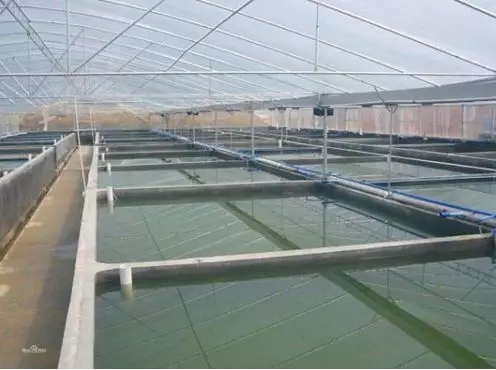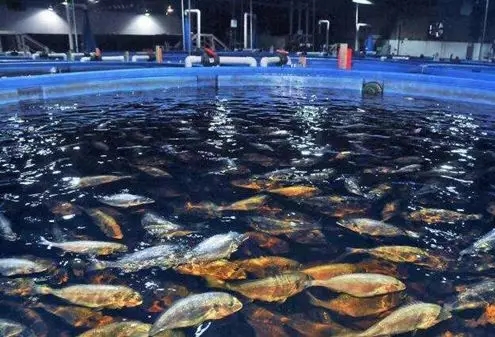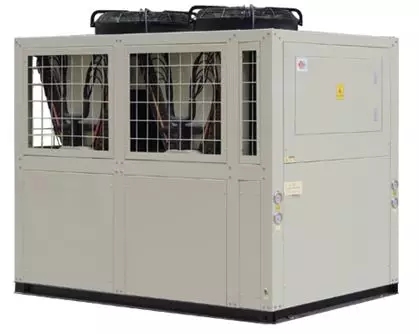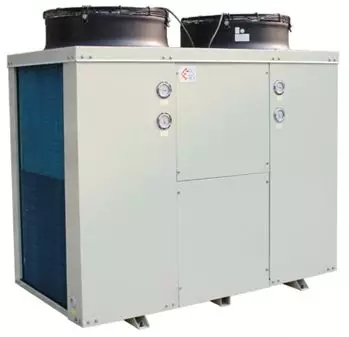With the development trend of modernized fisheries such as shrimp, crab and fish in factory farming, factory farming requires certain conditions. Controlling water temperature is a key technology. Shrimp, shellfish seedlings, groupers, squids, etc. require water temperature at 22 °C ~ 25 °C or so. In winter, the culture water needs to be warmed up. In summer, the culture water needs to be cooled. When the water temperature is controlled in a suitable environment, the breeding survival rate can be effectively improved and the breeding density can be greatly improved, thereby effectively improving the economic benefits of the farmers.

In terms of aquaculture constant temperature, most of the farmer equipment is backward. Many winter farms still rely on boiler burning coal mode, which not only pollutes the environment, but also solves the problem of heating in winter. When cooling seawater in summer, it is necessary to set up cooling equipment. . The traditional method of extracting underground seawater directly into seawater to reduce seawater temperature seriously wastes groundwater resources and destroys the water source environment required for breeding.

Aquaculture constant temperature method (1)
Aquaculture can be roughly divided into 2 categories according to the farming method and indoor requirements. This time, let us first popularize the first category: the heating pool heating tube heating constant temperature mode. This type of heating can be applied to almost all thermostats in aquaculture projects.
The water in the pool is dissipated (the surface of the pool is cooled to the environment, the heat of the pool to the pool and the wall, and the heat load required by the fresh water) causes the water temperature to drop. Therefore, it is necessary to ensure that the heat supplied to the pond meets the loss of the pool. The heat can guarantee the constant temperature of the water body. For the demand, the heat provided by our system design heat pump heating is equal to the maximum heat dissipation of the pool.
The temperature difference between the inlet and outlet water of the constant temperature pipeline of the tank body may be greater than the temperature difference between the feed water and the return water of the heat pump. Therefore, the system is designed to add an intermediate water tank to ensure the temperature of the inlet and outlet water of the water body is stable.
The factors affecting the selection of the heat pump main unit are the maximum heat loss rate of the water body. There are three factors affecting the heat dissipation of the water body: the heat dissipation from the pool to the environment, the heat dissipation from the water body to the bottom of the pool or the wall of the pool, and the heat demand from the new water. For the whole project, we must pay attention to the insulation of the greenhouse in the pool and the thermal insulation of the pool. It is also necessary to control the amount of water exchange to control the initial investment cost of the heat pump mainframe.
System application: If the maximum heat dissipation of the water body is calculated as A kw, then the heat pump host selection requires that the heat capacity of the host corresponding to the water output 45 ° C should be greater than or equal to A kw, the size of the intermediate insulation water tank is selected according to the size of the constant temperature system, the larger the water body The larger the constant temperature heat, the larger the water tank that needs to be configured.
System advantages: the two sides of the insulated water tank are the heat-consuming end and the heating end respectively. The heat supply and demand on both sides can ensure the water in the water tank is stable at 45~50 degrees, so that the heat pump main unit and the pool can be in a stable state. The service life will increase; the heating pipe directly heats the pool water, reducing the intermediate link and providing sufficient energy.
Aquaculture constant temperature method (2)
The second type of aquaculture constant temperature mode: aquaculture greenhouse temperature constant mode. This type of constant temperature method is applicable to projects with water temperature requirements below 20 °C (sea cucumber seedlings, etc.).
The constant temperature mode of the culture greenhouse is to directly control the temperature of the greenhouse environment to indirectly guarantee the water temperature. Compared with the heating method of the heating pipe of the pool, the system is simpler, the middle insulation water tank and a set of water pump are omitted, and the hot water heated by the host directly enters. The end fan coil is heated to reduce the heat loss on the side of the insulated water tank; the temperature control at the end is also relatively simple and accurate.
The constant temperature method of the culture greenhouse is more strict on the insulation of the greenhouse and the insulation of the pool wall. The water body cooling also includes three parts (the heat dissipation from the pool to the environment, the heat dissipation from the water body to the bottom of the pool or the wall and the addition of new water). Heat demand, however this system only thermostats the environment. It limits the heat dissipation of the pool to the environment. The bottom of the pool and the wall of the pool need to be insulated to reduce heat dissipation. In addition, the frequency of replacement of pool water during use also requires a reasonable and scientific plan to reduce the loss caused by water exchange.
The thermostat method of breeding greenhouses is not suitable for all projects that have a constant temperature of the greenhouse. If the water temperature requirement is too high, the heat required for heat dissipation of the entire water body cannot be satisfied in this way. The best application of the thermostat method for breeding greenhouses is the project with water temperature requirements below 20 °C.
The use of breeding greenhouses, water temperature can guarantee a constant temperature of more than 30℃, almost meet the constant water temperature requirements of all common breeding projects.
Aquaculture constant temperature method (3)
The third type of constant temperature mode: water heating. Changing water heating, as the name suggests, is to change the water temperature by changing the water. In the system, the heat pump continuously heats the water in the water storage tank, heats it to the required temperature within the allowable time, and then concentrates the time to change the water.
PS: The water tank size is the maximum daily water change.
The heat pump heats the water tank to ensure the water temperature of the water tank, and the water in the water tank is replaced with the water tank according to the needs of the culture tank. The whole system design is relatively simple, and the construction difficulty is relatively small.
For example: 1000m³ water aquaculture project, supplement 10% fresh water every day, the water source is seawater, the coldest temperature of seawater during breeding is 2 °C, and the culture pond needs a constant temperature of 18 °C.
1) The maximum daily water change is 1000×10%=100m³
2) The heat of 100m³ water from 2°C to 18°C is 1.163×100×(18-2)=1860.8 kW·h. Select the heat pump unit according to the above data, and consider the maximum initial reduction of equipment. Then the smaller the heat supply per hour, the smaller the selected unit.
3) It takes 2 hours to change the water every day. (provided by the breeding user, different projects, different time). According to the water change time, the daily running time of the unit can be set to 20h (reserved 2 hours of downtime)
4) The equipment required for water change is: 1860.8÷20=93.04kw.. Select a device with a heating capacity of 93.04kw to meet the constant temperature demand.
Aquaculture constant temperature method (4)
In addition to the three constant temperature methods introduced earlier, there is a constant temperature method for aquaculture. The reason for the long-flow mode is that the aquaculture water requires 24 hours of continuous hydration and drainage.
In the long-flow water constant temperature system, the increase of the plate exchange is to recover the heat in the drainage to improve the water supply to the heat pump unit and reduce the energy consumption.
For example: a long-flow aquaculture project requires a constant water temperature of 20 degrees, a water flow of 60 m³/h, and a new water temperature of 15 °C.
1) The heat required for constant temperature is 1.163×60×(20-15)=349kW
2) Plate replacement heat recovery: add new water 15 ° C, drain 20 ° C. The new water temperature after heat exchange is 17 °C.
3) The heat required for main unit heating is: 1.163 × 60 × (20-17) = 210kW
If you do not increase the heat exchange of the board, you need to select the 349kW capacity host. If you choose to recycle, you can use the host capacity of 210kW. Not only reduces initial investment, but also reduces the cost of later use.
Aquaculture constant temperature method (5)
The four columns before the aquaculture constant temperature method introduced the constant temperature mode of heating the heating tube of the culture pond, the constant temperature mode of the culture greenhouse, the water heating and the long water flow.
In this issue, we introduce the last type of constant temperature method: direct heating. Direct heating is often used in systems for recirculating aquaculture and water treatment.
Direct heating is generally the direct entry of water into the mainframe. Because the amount of oxygen and other components in the water is uncontrollable, it has certain harm to the host. Therefore, it is rarely used in practical cases.
H’Stars heat pump boosts the development of aquaculture industry
The current large-scale farming in the world is mainly freshwater aquaculture, marine aquaculture and shallow sea aquaculture. The main species of fish cultured are shrimp, squid, squid, tilapia, loach, grouper, scorpion and so on. In order to solve the problem of insufficient water and soil resources in local aquaculture and to avoid natural disasters in some areas, a factory system has been introduced to promote the recycling of aquaculture water. The ecological breeding constant temperature heat pump provides a constant water temperature for industrial farming.
In the face of this situation, the H.Stars air-cooled professional breeding heat pump unit launched by Stellar can obtain heat from the air, environmental protection and pollution-free, and can complete the winter fish pond heating and summer fish pond cooling, effectively solving the water temperature control problem of aquaculture. The stellar air energy constant temperature professional aquaculture heat pump professional provides a constant water temperature function for the factory farming system, which solves the practical problems for the farmers and has a wide application prospect. The heat pump is used as a heat source and a cold source to complete the heating and cooling of seawater. It is a low-energy, pollution-free heating and cooling technology that does not consume groundwater, and is in line with the current basic policies of China's energy and environmental protection and the strategic requirements for sustainable development of the national economy.


ltra-low temperature air source heat pump unit